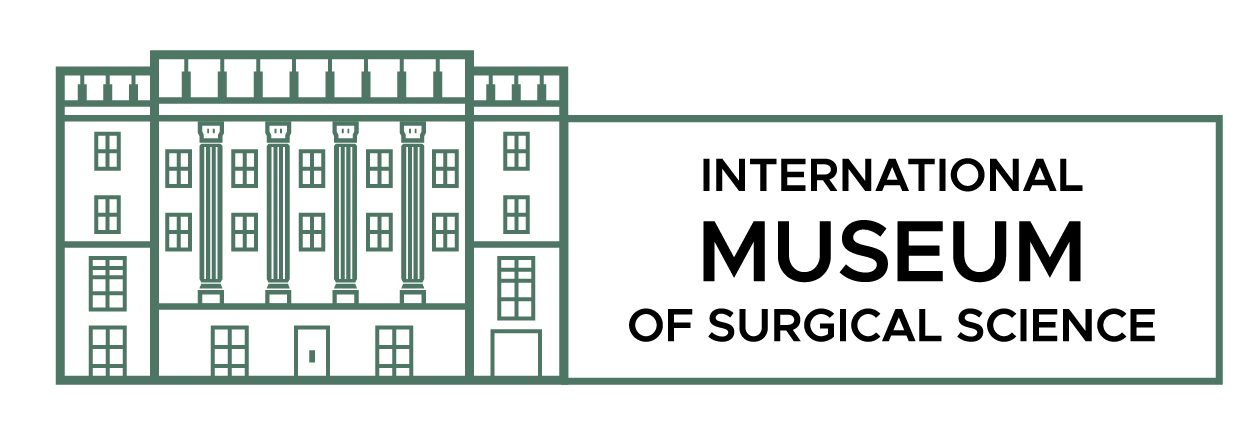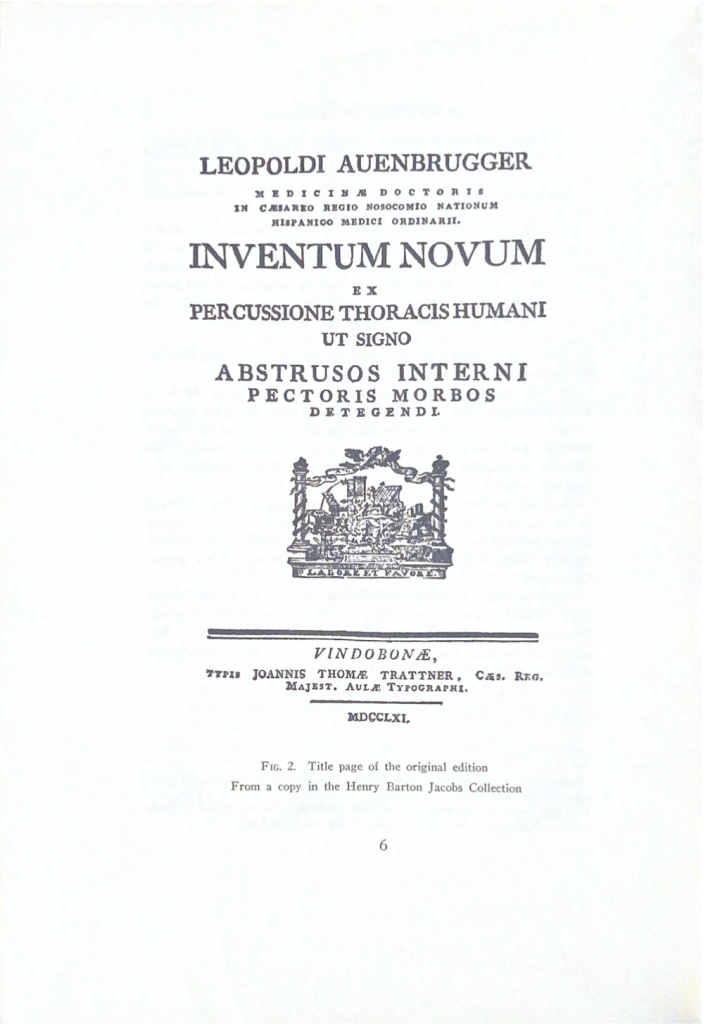Published by Erica Lande
On Percussion of the Chest, Being a Translation of Auenbrugger Original Treatise
entitled “ Inventum novum ex percussione thoracis humani, ut signo abstrusos interni pectoris morbos detegendi ”. [Vienna,1761] by John Forbes, M.D. [London, 1824]
You ail for home. Your chest tightens. You have nostalgia, das Heimweh. Josef Leopold Auenbrugger can hear the destruction of your cherished hopes, i.e., nostalgia, with his proposed method–percussion of the chest.
Auenbrugger published On Percussion of the Chest in 1761, during the drive to advance anatomical ideas, because he recognized that the diagnosis of respiratory diseases lacked the ability to catch asymptomatic diseases. Yet his ingenuity afforded not only him the capability to diagnose diseases of the chest but also the belief that percussion of the chest could diagnose mental afflictions.
Pathological anatomy and physiology weren’t advanced enough to diagnose. This meant physicians at the time were left uncertain of a patient’s chest organs’ condition, so no treatment could be directed. Meanwhile, on the frontier of anatomical diagnosis, Auenbrugger utilized his experienced ears. An innkeeper raised him; he became accustomed to the sound of patrons knocking on barrels in hopes of hearing the resonance of beer. Moreover, he possessed the trained ear of a musician. Thus, the idea of listening to the cavity of the chest fringed from his childhood in the inn and his musical background, i.e., he possessed the unique foundation to diagnose asymptomatic diseases accurately.
For the next 7 years, while a physician at the Spanish Hospital in Vienna, Auenbrugger clarified his method. He studied patients, observed autopsies, and experimented with cadavers by filling their lungs with fluids. Despite years of attention to detail and perfecting percussion of the chest, the method wasn’t readily adopted. The medical field was still stuck in a paradigm before pathological anatomy, i.e., the study of organs and tissues to understand diseases’ causes and effects. Auenbrugger’s method wouldn’t be implemented until 1808 when his treatise was translated by the French clinician named Corvisart.
Here are Auenbrugger’s interpretations of audible sounds from tapping the chest to inform treatment:
II.
The sound thus elicited (I.) from the healthy chest, resembles the stifled sound of a drum covered with a thick woollen cloth or envelope. (Auenbrugger, 1761, p. 8)
[This is comparable to the 70s’ dry drum sound heard in Fleetwood Mac’s Rumours]
…
XIV.
If the sonorous region of the chest appears, on percussion, entirely destitute of the natural sound – that is, if it yields only a sound like that of a fleshy limb when struck, – disease exists in that region.
Scholium. The nature of the indications above pointed out, will be understood by any one who attends to the difference of sound elicited by percussion of the chest, and of the thigh, in his own person. (Auenbrugger, 1761, p. 11)
However, mental afflictions, according to Auenbrugger, also influence what’s heard after performing percussion of the chest.
XXVII.
… 2. Mental affections, we find, produce quite opposite effects, while acting as causes of pectoral diseases. Of these affections of the mind I have observed none more powerful in rendering obscure the natural resonance of the chest, than the destruction of cherished hopes. And as among this class of diseases, Nostalgia (commonly called heimwehe – home ail) occupies the first place, I shall here give a short history of it. (Auenbrugger, 1761, p. 16)
The mentality of soldiers forced into military service captures them into a state of indifference towards the future because they lack the hope of ever returning home. In other words, Auenbruggrer explains the mental disorder of nostalgia leaves men thinking their life “gradually pines and wastes away, under the pressure of ungratified desires.” In an examination of these men, Auenbrugger uniformly found their lungs in likewise conditions. (Auenbrugger, 1761, p. 16)
Dr. Auenbrugger describes the desolate situation of a drafted soldier to provide an example of someone with nostalgia. Then, if the sound from the chest cavity of an afflicted soldier were heard during an anatomical examination of another person, Auenbrugger would be confident in claiming their mental state would be similar to that of the soldier. Both the soldier and the new patient are drowning in nostalgia.
Although percussion of the chest dates back to the 17th century, it is still in practice today with some modifications. What can be learned from Auenbrugger’s original treatise is that it expands beyond his methodology. As shown in this short piece, Auenbrugger also proposed the anatomical diagnosis of mental diseases. He was on the new frontier of medical advancement, and he wanted to help people. So, although he pushed past the limits of anatomical diagnosis, he recognized human suffering and used what he had, a unique sense of hearing and years of experience, in the hope of directing a treatment. He will not be forgotten for On Percussion of the Chest, but he should also be remembered for his drive to help others.
Works Cited:
Auenbrugger, Josef Leopold. On Percussion of the Chest, Being a translation of Auenbrugger’s Original Treatise entitled “Inventum novum ex percussione thoracis humani, ut signo abstrusos interni pectoris morbos detegendi ”. [Vienna,1761]. Translated by John Forbes, M.D. [London, 1824] Collection of the International Museum of Surgical Science. Case 13. Shelf 6. Position 10.
Erica Lande was the Spring 2023 Library Intern at the International Museum of Surgical Science. “My name is Erica Lande, graduated in December 2022 from University of Illinois Chicago with a B.A. in Philosophy. I enjoy exploring the intersection of philosophy and history, which led me to apply for the International Museum of Surgical Science Collections Internship. Currently, I serve at local non-profits, am a political affairs ambassador for The Borgen Project, and do outreach with Vera Creative. marketing firm. In my free time, I enjoy bodybuilding!”




